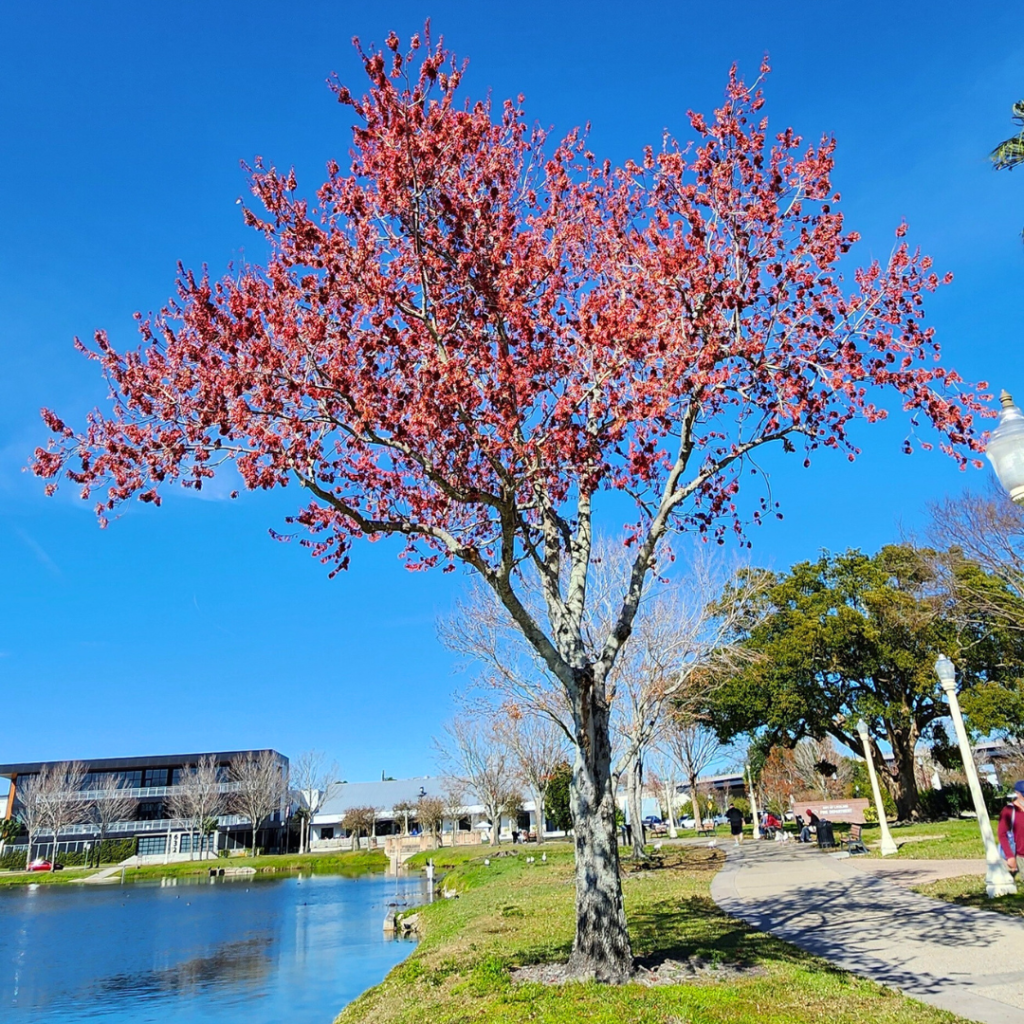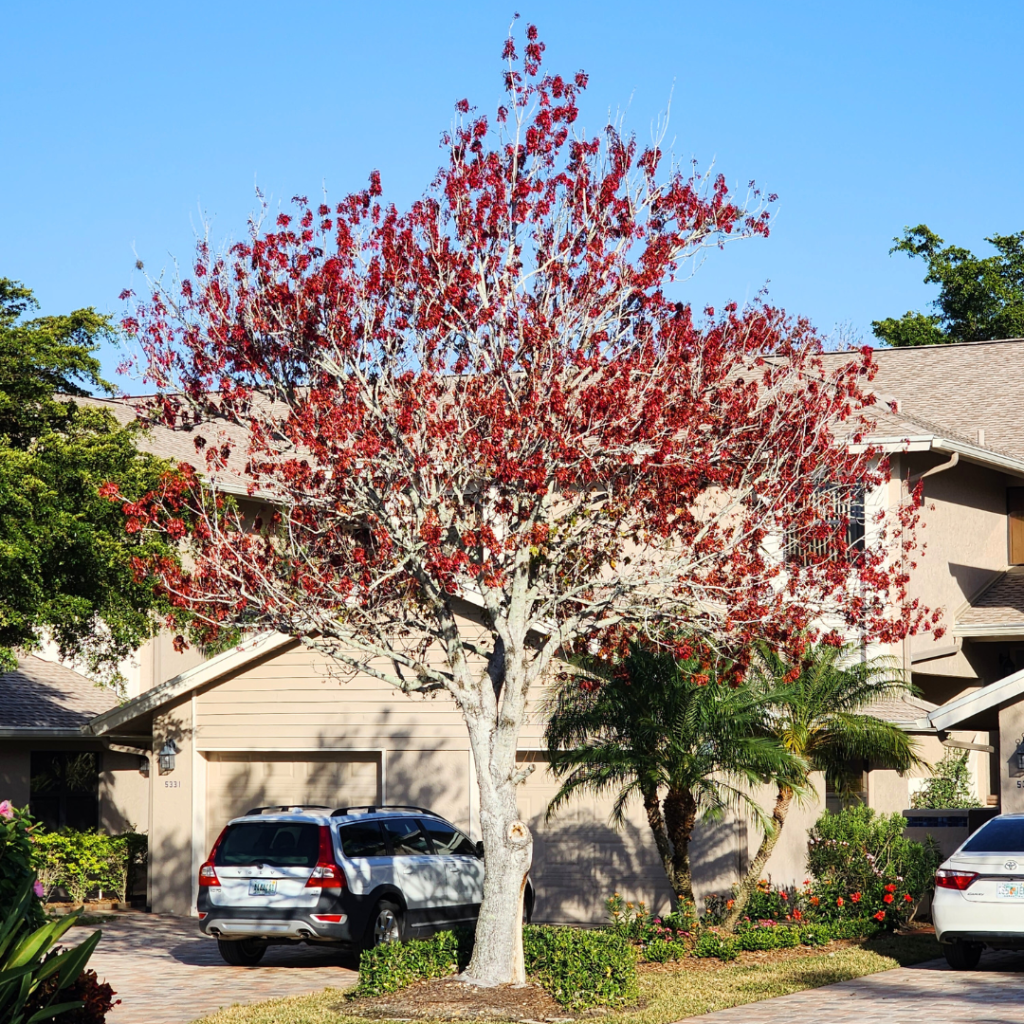A Top Choice for Native Seasonal Color

For many of Florida’s seasonal residents, finding a native tree that brings striking color to the landscape can be a challenge. Many northern favorites struggle in Florida’s climate, but the Red Maple (Acer rubrum) is an exception. True to its name, this native tree puts on a dazzling display of red—fiery foliage in fall, striking blooms in late winter, and vivid seeds in spring— only briefly resting in the depths of winter without leaves and color before bursting back to life with those blooms. For those seeking seasonal color in a native or Florida-Friendly landscape, the red maple is truly a standout choice.
Changing Color Through the Seasons
Red maple is one of the few native trees that truly showcases all-season beauty. During fall, its leaves turn brilliant shades of yellow, orange, and red, often lasting for several weeks. It is one of the first and only Florida trees to show autumn color, making it a standout in the landscape. While many deciduous trees can lose their visual appeal in winter with long dormancy periods, red maple after a short dormancy small but striking scarlet flowers that bloom in January. While primarily wind pollinated, its flowers could be important for pollinators when little else is in bloom as they do get visits by bees. But this isn’t a powerhouse for pollinators like other trees. Finally in spring, clusters of two-winged seeds emerge, providing yet another flush of red before the tree’s fresh green foliage takes over for the summer.
A Valuable Tree for Wildlife

Beyond aesthetics, red maple is an important tree for local wildlife. The seeds are a favorite for birds and squirrels, while its flowers can attract pollinators. Its moderate shade allows for an understory of plants to thrive beneath it, creating a layered habitat beneficial to many of Florida’s native wildlife species.
Considerations Before Planting
While red maple is a fantastic tree for seasonal color, it does have specific growing requirements and some drawbacks to consider.
- Moisture Needs – Also known as “swamp maple,” red maple naturally thrives in wetland areas. It prefers moist, acidic soil with high organic matter and does not tolerate drought well. In areas with well-drained or sandy soils, regular irrigation is necessary, especially during dry months. If planted in a spot with insufficient water, red maple may experience leaf scorch, where portions of the leaves die between the veins, particularly in hot, windy conditions.
- Growth and Structure – Red maple is a fast-growing tree, capable of reaching heights of up to 60 feet, although it often remains smaller in drier soil and the farther south (hotter areas) you plant it. However, its still rapid growth can lead to weaker wood and structural issues. The tree requires pruning to develop a strong form, particularly in its early years. Selecting branches with wide angles from the trunk and removing those that grow too large in proportion to the trunk can help prevent breakage.
- Wind Resistance – One of red maple’s biggest drawbacks is its susceptibility to storm damage. While it tolerates Florida’s heat and pests well, its wood is relatively weak, making it prone to damage in high winds. Many of the red maples at our UF/IFAS Extension office suffered significant damage from hurricanes Ian, Milton, and Helene. If you live in an area prone to hurricanes, careful pruning and proper placement away from structures can help minimize potential storm-related risks.

Red Maple in a coastal Sarasota home landscape. Roughly a block away from the Gulf of Mexico this plant was still putting on a January show!
Best Practices for Planting and Care
To ensure your red maple thrives:
- Choose the right site. It grows best in full sun and acidic, moist soil.
- Irrigate for establishment and during drought. Even though it tolerates occasional dry conditions, consistent moisture will produce the healthiest tree.
- Prune strategically. Maintain a strong central leader and remove weak branches to improve storm resilience.
- Mulch properly. A good layer of mulch will help maintain soil moisture and prevent root exposure. Make sure you follow the donut method and avoid volcanos!
A Worthy Choice for Seasonal Residents
For snowbirds and seasonal residents wanting a tree that mimics the color changes of northern landscapes, red maple is one of Florida’s best options. It delivers vibrant foliage in fall, striking blooms in late winter, and fresh red growth and seeds in spring, ensuring your yard remains lively throughout most of the seasons. While it requires some care and you should expect breakage in hurricane-prone areas, its beauty and wildlife benefits still make it a worthy addition to our landscapes.
Resources:
- UF/IFAS EDIS document on Red Maple: https://edis.ifas.ufl.edu/publication/ST041
- UF/IFAS Gardening Solutions of Red Maple: https://gardeningsolutions.ifas.ufl.edu/plants/trees-and-shrubs/trees/red-maple/
- Florida Native Plant Society on Red Maple: https://www.fnps.org/plant/acer-rubrum
- Natives for your Neighborhood on Red Maple: https://regionalconservation.org/beta/nfyn/plantdetail.asp?tx=Acerrubr
During the preparation of this work, the author used ChatGPT to help build the blog post. After using this tool/service, the author reviewed and edited the content, and takes full responsibility for the content of the publication.
 4
4

